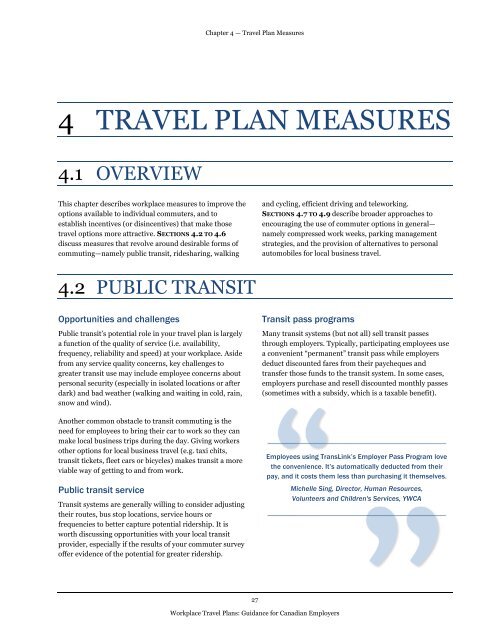Workplace Travel Plans - main body - Final Jan 2010 ENGLISH - FCM
Workplace Travel Plans - main body - Final Jan 2010 ENGLISH - FCM
Workplace Travel Plans - main body - Final Jan 2010 ENGLISH - FCM
You also want an ePaper? Increase the reach of your titles
YUMPU automatically turns print PDFs into web optimized ePapers that Google loves.
Chapter 4 — <strong>Travel</strong> Plan Measures<br />
4 TRAVEL PLAN MEASURES<br />
4.1 OVERVIEW<br />
This chapter describes workplace measures to improve the<br />
options available to individual commuters, and to<br />
establish incentives (or disincentives) that make those<br />
travel options more attractive. SECTIONS 4.2 TO 4.6<br />
discuss measures that revolve around desirable forms of<br />
commuting—namely public transit, ridesharing, walking<br />
and cycling, efficient driving and teleworking.<br />
SECTIONS 4.7 TO 4.9 describe broader approaches to<br />
encouraging the use of commuter options in general—<br />
namely compressed work weeks, parking management<br />
strategies, and the provision of alternatives to personal<br />
automobiles for local business travel.<br />
4.2 PUBLIC TRANSIT<br />
Opportunities and challenges<br />
Public transit’s potential role in your travel plan is largely<br />
a function of the quality of service (i.e. availability,<br />
frequency, reliability and speed) at your workplace. Aside<br />
from any service quality concerns, key challenges to<br />
greater transit use may include employee concerns about<br />
personal security (especially in isolated locations or after<br />
dark) and bad weather (walking and waiting in cold, rain,<br />
snow and wind).<br />
Another common obstacle to transit commuting is the<br />
need for employees to bring their car to work so they can<br />
make local business trips during the day. Giving workers<br />
other options for local business travel (e.g. taxi chits,<br />
transit tickets, fleet cars or bicycles) makes transit a more<br />
viable way of getting to and from work.<br />
Public transit service<br />
Transit systems are generally willing to consider adjusting<br />
their routes, bus stop locations, service hours or<br />
frequencies to better capture potential ridership. It is<br />
worth discussing opportunities with your local transit<br />
provider, especially if the results of your commuter survey<br />
offer evidence of the potential for greater ridership.<br />
Transit pass programs<br />
Many transit systems (but not all) sell transit passes<br />
through employers. Typically, participating employees use<br />
a convenient “permanent” transit pass while employers<br />
deduct discounted fares from their paycheques and<br />
transfer those funds to the transit system. In some cases,<br />
employers purchase and resell discounted monthly passes<br />
(sometimes with a subsidy, which is a taxable benefit).<br />
Employees using TransLink’s Employer Pass Program love<br />
the convenience. It’s automatically deducted from their<br />
pay, and it costs them less than purchasing it themselves.<br />
Michelle Sing, Director, Human Resources,<br />
Volunteers and Children's Services, YWCA<br />
27<br />
<strong>Workplace</strong> <strong>Travel</strong> <strong>Plans</strong>: Guidance for Canadian Employers

















